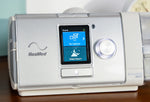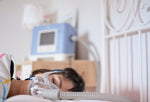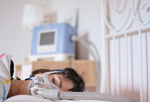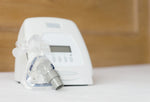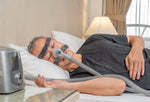On This Page
What Is a BiPAP Machine?
Our editorial process includes extensive measures to verify accuracy, provide clarity on complex topics, and present factual information. Read more
Key Takeaways
- A BiPAP machine (also called BPAP) delivers two different air pressures: one when you inhale and another when you exhale.
- Compared with CPAP devices, BiPAP’s dual-pressure design can improve comfort, especially when pressure needs are high, and make exhaling easier.
- BiPAP is often used for people with more complex or severe breathing issues, such as central sleep apnea, obesity hypoventilation syndrome, and COPD.
How Does BiPAP Work?
Like other positive airway pressure (PAP) therapy, a BiPAP machine sends pressurized air into the upper airway to keep it open during sleep and facilitate uninterrupted breathing. It delivers air at two different pressure levels: one when breathing in and another when breathing out.
- Inspiratory positive airway pressure (IPAP): IPAP is the level of air pressure provided by a BiPAP device while you're inhaling and is higher than the pressure during exhalation.
- Expiratory positive airway pressure (EPAP): EPAP is the level of air pressure delivered by the device during exhalation and is lower than IPAP, meaning you breathe out against a less forceful flow of air.
BiPAP therapy uses a small bedside machine that pressurizes air and pumps it through tubing. The tubing is attached to a mask worn over either the nose or both the nose and mouth. The pressurized air enters through the mask and flows into the upper airway.
BiPAP machines can operate in different modes:
- Spontaneous mode: The BiPAP machine switches between IPAP and EPAP levels based on your breathing.
- Timed mode: The machine delivers air on a set schedule.
- Spontaneous/timed (S/T) mode: The machine will send a stream of air if it detects that you haven't initiated a breath after a certain amount of time.
A doctor will determine which mode is most appropriate in your situation. They'll also determine the correct pressure settings based on your sleep study results. However, some BiPAP machines have sensors that track your breathing and adjust pressure levels in real time. These are called auto-titrating or auto-adjusting BiPAP machines.
What’s the Difference Between CPAP and BiPAP?
BiPAP and CPAP devices are both effective treatments for sleep apnea that use pressurized air to support more consistent breathing. The main difference between CPAP and BiPAP, though, is that CPAP provides a fixed level of air pressure, while BiPAP provides different pressure levels during inhalation and exhalation.
With a BiPAP device, lower air pressure during exhalation can make exhaling more comfortable, which is especially helpful for people whose treatment requires a high level of air pressure during inhalation.
However, BiPAP machines are rarely used as an initial treatment for OSA in people without other breathing difficulties. With their ability to operate in many different modes, BiPAP devices may be better suited to treat complex breathing problems, such as when a person has both obstructive and central sleep apnea (also called mixed or complex sleep apnea).
BiPAP machines tend to be more expensive than CPAP devices, and there may be fewer options available for travel BiPAP devices.
What Is a BiPAP Machine Used For?
BiPAP devices aren't widely used for initial treatment of obstructive sleep apnea. Instead, BiPAP therapy is generally prescribed if prior treatment with a CPAP or APAP machine wasn't effective. BiPAP therapy may also be suggested for people who have OSA alongside another breathing disorder like CSA.
Because it can be programmed to deliver air at regular intervals, BiPAP treatment can be used to normalize the breathing patterns of people with more complex conditions that may cause breathing during sleep to be irregular, too shallow, too slow, or too deep.
These conditions include:
- Central sleep apnea (CSA)
- Obesity hypoventilation syndrome (OHS)
- Chronic obstructive pulmonary disease (COPD)
- COVID-19 and respiratory failure
Who Is BiPAP Best For?
BiPAP therapy should only be used by certain people with sleep apnea and other breathing disorders. In people with OSA, BiPAP therapy is normally only used in select circumstances.
- Ineffectiveness of other PAP therapy: BiPAP therapy may be appropriate if OSA doesn't improve after trying treatment with a CPAP or APAP machine.
- Discomfort with CPAP: People who have trouble sticking with their CPAP treatment because they're uncomfortable exhaling against the incoming air pressure may benefit from trying a BiPAP device.
- Other breathing issues: BiPAP devices may be prescribed for people who have OSA along with another condition that interferes with consistent breathing, such as CSA, OHS, muscular dystrophy, or stroke.
In any specific situation, a doctor or sleep specialist can help determine if BiPAP therapy is appropriate.
What Are the Benefits of BiPAP?
Like other forms of PAP therapy, BiPAP treatment can potentially resolve sleep apnea and other sleep-related breathing problems. Benefits of effective treatment may include:
- Improved sleep with fewer unwanted awakenings
- Less daytime sleepiness
- Clearer thinking and improved memory
- Better mood
- Improved control of blood pressure
- Reduced snoring
- Lower risk of cardiovascular problems and other health complications associated with untreated sleep apnea
What Are the Side Effects of BiPAP?
There are few safety risks associated with PAP therapy, but some side effects are common, especially at the start of treatment. It's helpful for people who begin using a BiPAP machine to work with their doctor to troubleshoot side effects during the first few weeks. Common side effects can include:
- Nasal congestion or runny nose
- Upper respiratory infections
- Skin irritation from the mask
- Dry mouth
- Feelings of claustrophobia
- Nosebleeds
When side effects occur during BiPAP treatment, there are often steps that can help manage them. Changing the type of mask, adding a humidifier, asking your doctor about adjusting your pressure settings, ensuring equipment is cleaned properly, and other practical steps can frequently eliminate uncomfortable side effects.
How Do You Get a BiPAP Machine?
Getting a BiPAP machine involves a few essential steps, beginning with a proper diagnosis and prescription. Because BiPAP therapy delivers more advanced ventilatory support than standard CPAP, it's typically recommended only when medically necessary.
Diagnosis and Prescription
The first step toward getting a BiPAP machine is confirming whether you have sleep apnea or another breathing disorder that warrants bilevel therapy. Diagnosis may involve an overnight sleep study in a lab or an at-home sleep apnea test.
Sleep Doctor offers a convenient at-home sleep test that monitors your breathing, oxygen levels, and heart rate while you sleep in your own bed. Afterward, a licensed sleep physician reviews your results and determines whether BiPAP is appropriate or if CPAP or APAP should be tried first.
Because BiPAP machines are Class II medical devices, a prescription is required. Sleep Doctor can connect you with a licensed provider who can issue a prescription when medically appropriate.
Cost and Insurance Coverage
BiPAP machines tend to cost more than CPAP devices because they deliver two pressure settings and may include additional comfort or backup rate features. BiPAP machines can cost between $1,700 and $3,000, while CPAP machines cost between $500 and $1,000.
Most insurance providers—including Medicare—cover BiPAP therapy when it's medically necessary and when CPAP has already been attempted or ruled out. You may still be responsible for copays, deductibles, or ongoing supply costs. However, you may be able to purchase your BiPAP device using FSA or HSA funds. Check with your insurance provider to see what your plan covers.
Sleep Doctor offers transparent pricing and can provide documentation to help with insurance reimbursement if you decide to purchase your device out of pocket.
Where to Buy a BiPAP Machine
Once you have a prescription, you can buy a BiPAP machine through durable medical equipment (DME) suppliers, sleep clinics, or accredited online retailers.
Sleep Doctor also sells BiPAP machines directly, making it easy to move from diagnosis to treatment in one streamlined process. Our team can help you compare models, understand your prescribed pressure settings, and choose compatible masks and supplies. Buying through Sleep Doctor can simplify setup and ensure you have the support you need during the first weeks of therapy.
How Do You Use a BiPAP Machine?
Before you start BiPAP therapy, it's common for the device to be set up during an overnight sleep study. During the study, your health care provider or a sleep technician can help you select a comfortable mask and adjust the pressure settings on the BiPAP machine.
You will receive a user’s manual and instructions on how to operate and clean your machine. Always follow the instructions from the manufacturer, but in general, here's what to expect as you get started:
- Set up your machine on a stable surface near your bed and plug it into a power source.
- Assemble the tubing, mask, and humidifier (if included) according to the manufacturer’s instructions.
- Fill the humidifier chamber with distilled water if you plan to use heated humidity.
- Put on your mask and adjust the headgear to create a secure but comfortable seal.
- Turn on the BiPAP machine.
- Lie down in your preferred sleeping position and breathe normally.
It usually takes a few weeks to get used to using a PAP device. Be sure to communicate with your health care team if you have any problems using your device. Your doctor or sleep technician can often suggest changes to make BiPAP therapy more convenient and comfortable.
As you get started, taking certain steps may help you more quickly get used to BiPAP treatment.
- Make sure you're wearing the mask correctly: Test the mask for comfort, making sure it is neither too loose nor too tight. When worn properly, you should not hear air leaking out of the mask.
- Practice while you’re awake: Put on the mask and turn on the machine while you’re reading or watching TV to get used to how it feels. Take notes about any discomfort or other issues so you can review them with your health care provider.
- Be patient: It’s normal for it to take time to adjust to using PAP therapy at night, so don’t give up if you encounter challenges. It’s important to follow up with your doctor to troubleshoot and make adjustments.
How Do You Clean a BiPAP Machine?
Cleaning your BiPAP machine is essential for preventing mold, bacteria, and mineral buildup, all of which can affect your health and reduce the device’s effectiveness. Regular cleaning also helps extend the life of the mask, tubing, and humidifier.
Daily Cleaning
- Mask: Wash the mask cushion with warm water and mild, fragrance-free soap. Rinse thoroughly and let it air dry.
- Humidifier chamber: Empty leftover water each morning and allow the chamber to dry completely before refilling at night.
Weekly Cleaning
- Disassemble the mask, tubing, and humidifier chamber.
- Wash each part in warm, soapy water using a mild, non-antibacterial soap.
- Rinse well to remove all soap residue.
- Air-dry all components on a clean towel away from direct sunlight.
- Wipe down the machine exterior with a slightly damp cloth. Never submerge the device or get water inside the air outlets.





